Large Scale Social Kurdish Turmoil - 6-7 October 2014 - Turkey
DRK CASE STUDY
External Developments; Potential Repercussions For Turkey
Subject: Large scale social Kurdish turmoil - 6-7 October 2014 - Turkey
Background
Syrian regime forces withdrew from Kobane, which is supposedly one of the three cantons of projected Syrian Kurdish entity (Rojava) in 2012. This encouraged PYD (Democratic Union Party) to take control of the region imminently. Thus, armed branch of PYD, YPG, which is a sister terrorist organization of PKK, had ambitiously tried to establish control in this area in September 2014. Turkey was also apparently interested in the issue due to the very close proximity of Kobane to its border district of Suruç/Şanlıurfa. ISIS existence in Kobane was a major obstacle against the establishment of Kobane Canton which was thought to extend up to Euphrates River. However Kurdish forces have failed to attain this objective to defeat ISIS. 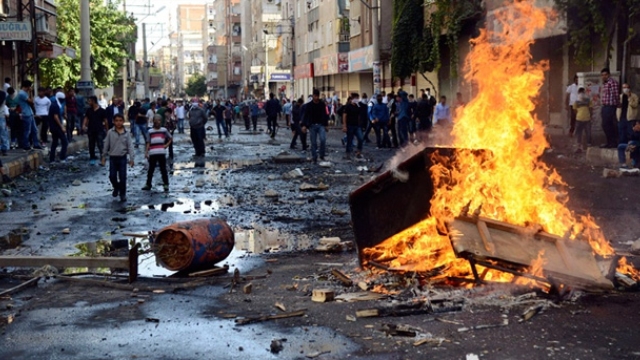 This failure, along with the alleged massacres in Kobane emotionally enacted Kurdish people living in Turkey to react against the developments. That reaction had also found a political response within the Turkish political atmosphere of those times (“Solution Process” for Kurdish quest). Thus, HDP (People’s Democratic Party), benefiting from the current political atmosphere did readily try to exploit the condition and called for the Kurdish society to demonstrate strongly against developments in Kobane. Starting with mass public demonstrations on September 26, with the march of the mass crowds to Suruç, demonstrations evolved into with mass protests in well-known Southeast cities of Diyarbakır, Şanlıurfa, Şırnak and Mardin. The demonstrations later turned into vandal attacks not only against security forces but also against the public facilities and institutions. Extensive levels of demonstrations caused serious damages and losses throughout the region. Increasing social tensions have urged Turkish Government to assist YPG forces by providing them with an access corridor to Kobane through Turkish territory.
This failure, along with the alleged massacres in Kobane emotionally enacted Kurdish people living in Turkey to react against the developments. That reaction had also found a political response within the Turkish political atmosphere of those times (“Solution Process” for Kurdish quest). Thus, HDP (People’s Democratic Party), benefiting from the current political atmosphere did readily try to exploit the condition and called for the Kurdish society to demonstrate strongly against developments in Kobane. Starting with mass public demonstrations on September 26, with the march of the mass crowds to Suruç, demonstrations evolved into with mass protests in well-known Southeast cities of Diyarbakır, Şanlıurfa, Şırnak and Mardin. The demonstrations later turned into vandal attacks not only against security forces but also against the public facilities and institutions. Extensive levels of demonstrations caused serious damages and losses throughout the region. Increasing social tensions have urged Turkish Government to assist YPG forces by providing them with an access corridor to Kobane through Turkish territory.
What happened?
Murat Karayılan, so-to-speak chairman of KCK Executive Committee (Kurdistan Communities Union), joined into the provocations with his statement on September 23 as that Solution Process between PKK and Turkish Government was over. 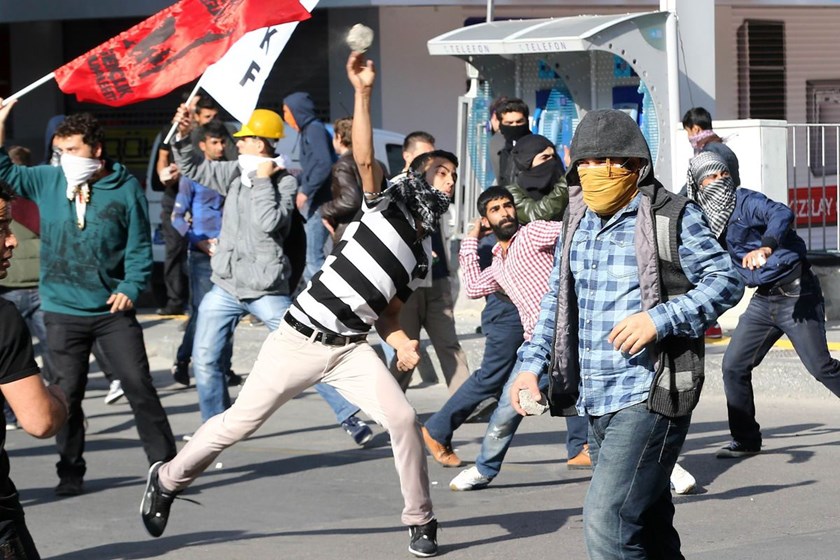 In parallel, on October 5, KCK Executive Committee even further called for the invasion of metropolitans and urged Kurdish society to demonstrate their objections against Turkish Government’s attitude towards Kobane. As a prominent propaganda material, Turkey was highly blamed of providing support to ISIS. This caused thousands of people to pour into the streets in a vandal manner. Thus, KCK and HDP’s call for sine die protests created large-scale demonstrations in 35 provinces. Protestors attacked with stones, Molotov cocktails and fireworks against security forces and public facilities even including the schools. Protestors plundered into many public buildings, while setting ATMs, city surveillance cameras, streetlights and school buildings on fire. Total loss was about 100.000.000 Turkish Liras. (Roughly 30.000.000 USD) Mass events were responded by intensive operations of security forces.
In parallel, on October 5, KCK Executive Committee even further called for the invasion of metropolitans and urged Kurdish society to demonstrate their objections against Turkish Government’s attitude towards Kobane. As a prominent propaganda material, Turkey was highly blamed of providing support to ISIS. This caused thousands of people to pour into the streets in a vandal manner. Thus, KCK and HDP’s call for sine die protests created large-scale demonstrations in 35 provinces. Protestors attacked with stones, Molotov cocktails and fireworks against security forces and public facilities even including the schools. Protestors plundered into many public buildings, while setting ATMs, city surveillance cameras, streetlights and school buildings on fire. Total loss was about 100.000.000 Turkish Liras. (Roughly 30.000.000 USD) Mass events were responded by intensive operations of security forces.
 Protest and Vandalism were not solely limited with southeastern regions. In the West, İstanbul was the number one province with huge amount of public damage occurred. Protests also took place in Ankara and Bursa, where police officers took lots of people under custody who joined into the demonstrations. Events caused massive amount of social disturbance so that even exclusive food deliveries were needed to be made to civilians who were affected by the brutality of the protests.
Protest and Vandalism were not solely limited with southeastern regions. In the West, İstanbul was the number one province with huge amount of public damage occurred. Protests also took place in Ankara and Bursa, where police officers took lots of people under custody who joined into the demonstrations. Events caused massive amount of social disturbance so that even exclusive food deliveries were needed to be made to civilians who were affected by the brutality of the protests.
Consequences
Number of Buildings Damaged During Kobane Events
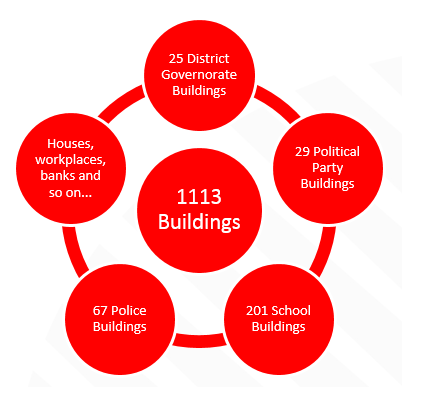
Source: Anadolu Agency
Total Amount of Casualties During Kobane-related Events
 Kobane events caused the fatality of dozens of people. Hundreds of people were also wounded. Even so, Yasin Börü, 16 year-old boy, with his 3 friend were killed and burned by the protestors. Their deaths attracted substantial reactions all around Turkey. On October 9, a joint declaration - under the leadership of HDP - of major Kurdish political figures as; DBP (Democratic Regions Party) – DTK (Democratic Society Party) - called for cease of violence and provocations. However, KCK continued to insist upon provocations against the detention of demonstrators. The terror that they created resulted in the deaths of 31 civilians and 2 police officers. Only in Diyarbakır, 12 innocent civilian people were killed by PKK terrorist organization supporters.
Kobane events caused the fatality of dozens of people. Hundreds of people were also wounded. Even so, Yasin Börü, 16 year-old boy, with his 3 friend were killed and burned by the protestors. Their deaths attracted substantial reactions all around Turkey. On October 9, a joint declaration - under the leadership of HDP - of major Kurdish political figures as; DBP (Democratic Regions Party) – DTK (Democratic Society Party) - called for cease of violence and provocations. However, KCK continued to insist upon provocations against the detention of demonstrators. The terror that they created resulted in the deaths of 31 civilians and 2 police officers. Only in Diyarbakır, 12 innocent civilian people were killed by PKK terrorist organization supporters.
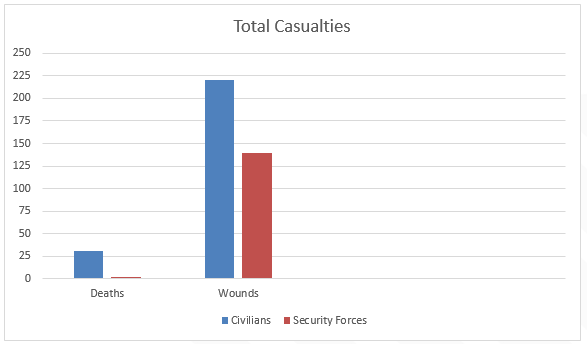
Source: Anadolu Agency
Considerations
HDP, in this process, aimed to seize initiative over Kurdish nationalism as to increase its political gains. Thus, HDP contributed into violence as an internal politics leverage. As such, they were observed to have tried to improve their effects in political realm by triggering the increase of public demonstrations. However, as the events went out of control, they turned out to arise as an existential crisis for HDP itself.
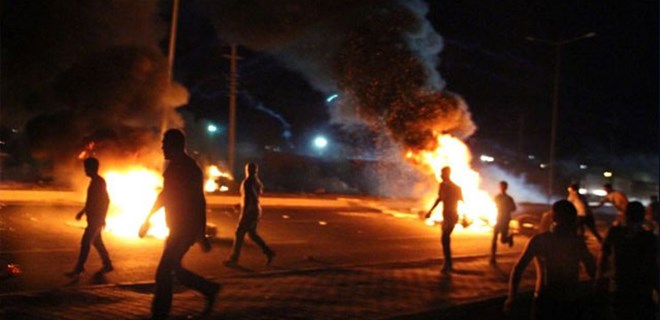 Also in this process, it was witnessed that there occurred a clash between political and military actors of the Kurdish front, while PKK had insisted upon its provocations until the very end of the events. On the other hand, Kurdish front univocally accused Turkish state of supporting Islamist fundamentalism in northern Syria.
Also in this process, it was witnessed that there occurred a clash between political and military actors of the Kurdish front, while PKK had insisted upon its provocations until the very end of the events. On the other hand, Kurdish front univocally accused Turkish state of supporting Islamist fundamentalism in northern Syria.
The crisis in Kobane also created a migration wave towards Turkey. The immigrants were rushed into Turkey where they were welcomed and provided shelter and food by the Government. However, some of these people were open to manipulations by PKK terrorist organization and Government’s control over these people has been important since then.
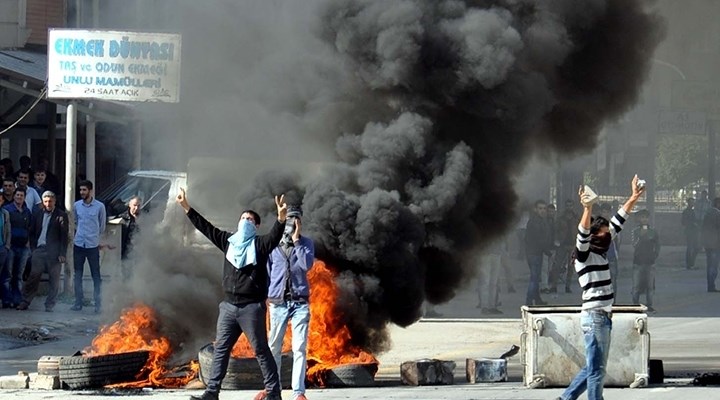 As another angle of approach, the events were commented and diagnosed as the “rehearsal” of a “Trench Warfare” practice. And this proved to be true with the start of conventional internal clashes between security forces, in the second half of 2015 in many Southeastern districts.
As another angle of approach, the events were commented and diagnosed as the “rehearsal” of a “Trench Warfare” practice. And this proved to be true with the start of conventional internal clashes between security forces, in the second half of 2015 in many Southeastern districts.
The events also revealed a major discrepancy between Kurdish military-political and social wings revealed. As such, political wing (HDP) tried to leverage the issue towards a political end with a view to express the ethnic rights of the Kurds in Turkey. However, this policy failed apparently due to the dominance of military wing, PKK terrorist organization. Consequently, these events caused a situation where Turkey’s level of democracy became questionable in global aspect.
Possible Future Repercussions
The most significant implication to be derived from Kobane events is that a tiny spark of Kurdish nationalism, related to the establishment of so-called belt in Northern Syria might escalate subsequent repercussions within Turkey’s southeast and even in western cities where there is a Kurdish population inhabited.

In connection with the current developments as of October 2017, DRK finds it necessary to remind that Turkish army started to establish observation points in Idlib region and has been seemingly conducting a high-level military mobilization along the Syrian border across Afrin.
